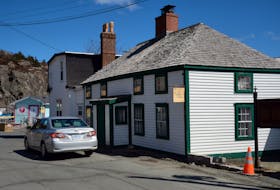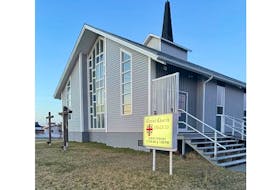“We’ve had a number of women murdered here in the Bay St. George area,” Pike said following the reading of the names of 109 women and children as part of the Faceless Doll event Monday night in Flat Bay.
A total of eight events will take place across the province throughout February, which is Violence Prevention Month.
Pike, of the Newfoundland Aboriginal Women’s Association, said dolls created on a quilt represent strong and beautiful women and children who have become the “faceless” victims of crime.
The local project was created to document when and how these people died and, more importantly, to let those in attendance Monday night — 20 people in total — know who the victims really were based on information provided by family members.
The information documents how each died said Pike, in order to continually remind everyone about how precious life is and that domestic violence is still a problem in communities.
“Most of the murders committed were (by) somebody they knew, and that’s why it’s so important to try and prevent family violence,” Pike said.
Mary White, also of the Newfoundland Aboriginal Women’s Network, said it’s important to work with women who are victims of violence, but there must also be a balance of working with men towards ending violence.
Both White and Pike recently attended a pre-inquiry session in Halifax, N.S. in a supportive role for family members from this area, leading up to a national inquiry into missing and murdered indigenous women and girls.
“While listening to these names and some details of how they died tonight is difficult, it’s 100 times harder to sit in a room and listen to families give their stories,” White said.
“It’s heart-wrenching.”
Flat Bay Band Chief Liz LaSaga feels the often graphic details surrounding these deaths are important to remember so governments know the memories of those represented by the faceless dolls won’t be lost.
The names of the women and children date from the 1700s to the present. As each name was read, a candle was placed in the victim’s honour during the somber ceremony.
As the Faceless Doll presentations continue across the province this month, Pike anticipates more names to be gathered. She said the number has already increased from 109 to 117.
Another Faceless Doll presentation takes place from 7-10 p.m. at the K'Taqmkuk Mi'Kmaq Museum in St. George’s tonight, and in Corner Brook from 1-4 p.m. Saturday at Bennett Hall, 11 West St.
Faceless Doll Project
• The Native Women’s Association of Canada (NWAC) released a report in 2010 called “What Their Stories Tell Us.”
• Report resulted from five years of research by the Sisters in Spirit Initiative, revealing as many as 582 known cases of Aboriginal women and girls who have gone missing or been murdered in Canada.
• NWAC wanted to create a visual representation of these women and girls so they would not be forgotten.
• The Faceless Doll Project came out of research conducted by the Ontario Native Women’s Association.
• The first faceless doll project for Newfoundland and Labrador began in March 2013 by the St. John’s Native Friendship Centre and transformed the dolls into a quilt in 2014. Their quilt told the stories of 98 women and children.
• In 2015, the Newfoundland Aboriginal Women’s Network gets involved in project with 109 women and children identified up to May 2014.
• Faceless doll presentations take place during February, Violence Prevention Month, in eight locations throughout Newfoundland and Labrador in 2016, with 117 women and children now identified and more anticipated.
Source: Newfoundland Aboriginal Women’s Network
“We’ve had a number of women murdered here in the Bay St. George area,” Pike said following the reading of the names of 109 women and children as part of the Faceless Doll event Monday night in Flat Bay.
A total of eight events will take place across the province throughout February, which is Violence Prevention Month.
Pike, of the Newfoundland Aboriginal Women’s Association, said dolls created on a quilt represent strong and beautiful women and children who have become the “faceless” victims of crime.
The local project was created to document when and how these people died and, more importantly, to let those in attendance Monday night — 20 people in total — know who the victims really were based on information provided by family members.
The information documents how each died said Pike, in order to continually remind everyone about how precious life is and that domestic violence is still a problem in communities.
“Most of the murders committed were (by) somebody they knew, and that’s why it’s so important to try and prevent family violence,” Pike said.
Mary White, also of the Newfoundland Aboriginal Women’s Network, said it’s important to work with women who are victims of violence, but there must also be a balance of working with men towards ending violence.
Both White and Pike recently attended a pre-inquiry session in Halifax, N.S. in a supportive role for family members from this area, leading up to a national inquiry into missing and murdered indigenous women and girls.
“While listening to these names and some details of how they died tonight is difficult, it’s 100 times harder to sit in a room and listen to families give their stories,” White said.
“It’s heart-wrenching.”
Flat Bay Band Chief Liz LaSaga feels the often graphic details surrounding these deaths are important to remember so governments know the memories of those represented by the faceless dolls won’t be lost.
The names of the women and children date from the 1700s to the present. As each name was read, a candle was placed in the victim’s honour during the somber ceremony.
As the Faceless Doll presentations continue across the province this month, Pike anticipates more names to be gathered. She said the number has already increased from 109 to 117.
Another Faceless Doll presentation takes place from 7-10 p.m. at the K'Taqmkuk Mi'Kmaq Museum in St. George’s tonight, and in Corner Brook from 1-4 p.m. Saturday at Bennett Hall, 11 West St.
Faceless Doll Project
• The Native Women’s Association of Canada (NWAC) released a report in 2010 called “What Their Stories Tell Us.”
• Report resulted from five years of research by the Sisters in Spirit Initiative, revealing as many as 582 known cases of Aboriginal women and girls who have gone missing or been murdered in Canada.
• NWAC wanted to create a visual representation of these women and girls so they would not be forgotten.
• The Faceless Doll Project came out of research conducted by the Ontario Native Women’s Association.
• The first faceless doll project for Newfoundland and Labrador began in March 2013 by the St. John’s Native Friendship Centre and transformed the dolls into a quilt in 2014. Their quilt told the stories of 98 women and children.
• In 2015, the Newfoundland Aboriginal Women’s Network gets involved in project with 109 women and children identified up to May 2014.
• Faceless doll presentations take place during February, Violence Prevention Month, in eight locations throughout Newfoundland and Labrador in 2016, with 117 women and children now identified and more anticipated.
Source: Newfoundland Aboriginal Women’s Network








